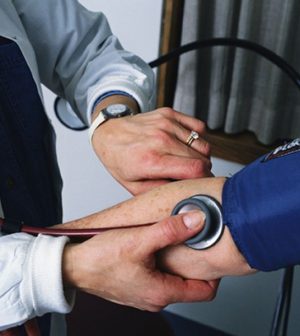- Navigating Your Midlife Crisis: Embracing New Possibilities
- City Raccoons Showing Signs of Domestication
- Mapping the Exposome: Science Broadens Focus to Environmental Disease Triggers
- One Week Less on Social Media Linked to Better Mental Health
- Your Brain Changes in Stages as You Age, Study Finds
- Some Suicide Victims Show No Typical Warning Signs, Study Finds
- ByHeart Formula Faces Lawsuits After Babies Sickened With Botulism
- Switch to Vegan Diet Could Cut Your Greenhouse Gas Emissions in Half
- Regular Bedtime Does Wonders for Blood Pressure
- Dining Alone Could Mean Worse Nutrition for Seniors
Everyday Foods for Better Blood Pressure

High blood pressure, or hypertension, is a risk factor for stroke, heart disease and other dangerous conditions, but it offers no early warning signs. That’s why it’s so important to have your pressure checked regularly.
You can take preventive steps to keep it in line by getting regular exercise and by adding foods that support a healthy blood pressure to your diet.
If you’ve already been diagnosed with high blood pressure, follow your doctor’s orders on medication, but know that a better diet is essential to help those medications work — it might even reduce the number of drugs you need.
Healthy diets, like DASH (Dietary Approaches to Stop Hypertension), focus on lowering salt and boosting the minerals calcium and potassium through food. Vegetarians and vegans, in particular, tend to have significantly lower blood pressure and lower odds of hypertension than non-vegetarians, in part from all the extra vegetables and fruits (and their fiber) they eat. These are healthful foods everyone can enjoy more of.
What other foods can help? Make sure you’re getting between 1,000 and 1,300 milligrams (mg) of calcium every day from foods like milk and yogurt. A report in the Cochrane Database of Systematic Reviews found that 1,500 mg was even more effective.
The omega-3 fatty acids in flax seeds seem to be particularly good for blood pressure. Buy whole brown or golden seeds and store them in the fridge for freshness. Grind them up in a coffee bean or spice grinder as you need them and sprinkle on yogurt and cereal, mix into batters and use as a coating instead of flour or breadcrumbs. Aim for one to two tablespoons a day. Note: Your body can’t extract the nutrients from whole seeds so you must grind them before eating.
Garlic has many health benefits, so use it liberally in cooking.
And if you enjoy sipping herbal tea to unwind, reach for hibiscus tea, which was found to help adults with pre- and mild high blood pressure, according to a study published recently in The Journal of Nutrition.
More information
Get all the details on the DASH Diet from the U.S. National Heart, Lung, and Blood Institute.
Source: HealthDay
Copyright © 2025 HealthDay. All rights reserved.










